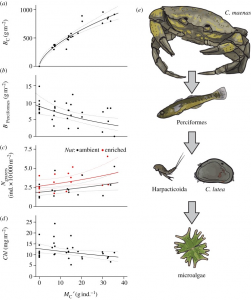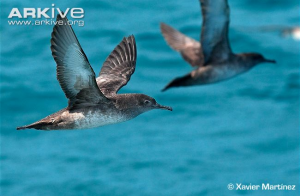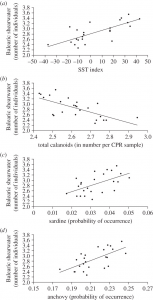Environmental change is affecting communities and ecosystems in a number of different ways. One of the effects it is having is on food webs. A food web is a collection of both interconnected and independent food chains which represent all predator prey relationships in an ecosystem or community as well as the primary producers at the bottom.
There are two main ways in which environmental change can affect food webs. The effect could be top down, where environmental change affects the number of predators at the top of the food web and such change brings about a change in the number of organisms lower in the food web. This change can have disastrous effects on the ecosystem. Conversely the effect could be bottom up, where environmental change has affected the number of primary producers, organisms such as grass, which form the foundation of the food web; this would in turn affect organisms higher in the food web. This again could have severe negative effects on the ecosystem or community. The effect that is caused by the change of abundance of either the top predators or primary producers is known as a trophic cascade.
Figure 1 illustrates an example of a potential trophic cascade which could be caused by environmental change where there is a reduction of the average individual body mass of the top predator, the shore crab Carcinus maenas, in this marine ecosystem. Reduction in body mass is a common response to climate change (Gardner et al. 2011). The reduction in the body mass of the crabs increased the biomass, the total weight of organisms in an ecosystem or community, of the community. The reduction in body mass of the shore crab increased the number, and consequently the biomass, of the intermediate fish predators that the shore crab feeds upon. The increased abundance of fishes reduced the numbers of the algae eating organisms. The fall in the number of algae eating organisms obviously led to an increase in algae, this increase could lead to algal blooms which can be devastating to ecosystems. (Jochum et al. 2012).


An example of an actual trophic cascade, which is illustrated in figure 3, is the effect of sea temperature on the Balearic shearwater, Puffinus mauretanicus (Figure 2). As sea temperatures rose in the late 1990s the bird’s range spread northwards (Wynn et al. 2007) resulting in an increase in its population numbers. A concentration of the population further north resulted in an increased occurrence of anchovies and sardines, both prey of the Balearic shearwater, in the Bay of Biscay. The increased occurrence of anchovies and sardines resulted in a decrease in calanoids, calanoids make up a significant proportion of plankton (Blaxter et al. 1998) and so are an important food source in the ecosystem. (Luczak et al. 2011)

Trophic cascades can be disastrous as they can result in the total collapse of ecosystems and are an often overlooked result of environmental change and the effect it can have on ecosystems or communities.
References:
Blaxter, J. H., Douglas, B., Tyler, P. A., & Mauchline, J. (1998). The biology of calanoid copepods (Vol. 33). Academic Press.
Gardner, J.L., Peters, A., Kearney, M.R., Joseph, L. and Heinsohn, R., 2011. Declining body size: a third universal response to warming?. Trends in ecology & evolution, 26(6), pp.285-291.
Jochum, M., Schneider, F.D., Crowe, T.P., Brose, U. and O’Gorman, E.J., 2012. Climate-induced changes in bottom-up and top-down processes independently alter a marine ecosystem. Philosophical Transactions of the Royal Society of London B: Biological Sciences, 367(1605), pp.2962-2970.
Luczak, C., Beaugrand, G., Jaffre, M. and Lenoir, S., 2011. Climate change impact on Balearic shearwater through a trophic cascade. Biology Letters, 7(5), pp.702-705.
Martinez X. Balearic shearwaters in flight. Accessed 16 March 2017 <http://www.arkive.org/balearic-shearwater/puffinus-mauretanicus/image-G75476.html#src=portletV3>
Wynn, R.B., Josey, S.A., Martin, A.P., Johns, D.G. and Yésou, P., 2007. Climate-driven range expansion of a critically endangered top predator in northeast Atlantic waters. Biology Letters, 3(5), pp.529-532.
499 Words
Recent Comments